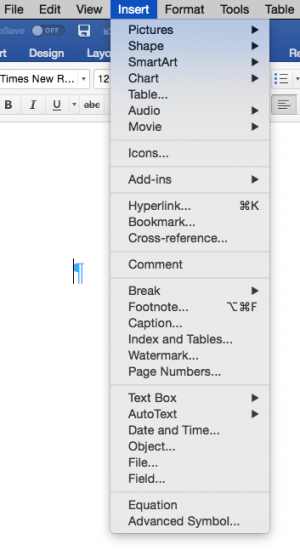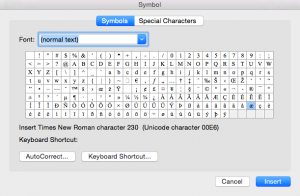This is an old revision of the document!
Table of Contents
Symbols & Abbreviations/Acronyms
Symbols
Symbols will need to be replaced using Advanced Symbol in Word. Simply go to the top menu bar in word, select the dropdown menu for Insert and select Advanced Symbol.

This will open up a new window.

Then you just have to select the appropriate symbol and click Insert.
Using Unicode for Symbols
For any symbols that aren’t in Word, you will need to insert the symbol using Unicode. First, you will need to set up your keyboard for Unicode input.
List of Control Characters for Unicode
Graphemica - Find the unicode for all characters
Once your keyboard is set up you can insert the symbol.
For a Mac press and hold the Option key as you enter the appropriate code. For Windows it is the same process but with the Alt key.
Abbreviations & Acronyms
We keep abbreviations as they appear in the text.
Q&A Archive
Q: Stay the Blazes Home makes frequent reference to COVID-19 with COVID being capitalized. I realize this is an acronym and so we would usually leave it capitalized, but I'm wondering if I can change it to lower case letters due to the frequency used (I don't want it to be jarring to the reader to have the letters read out each time) and because people often pronounce it "covid" in everyday speech? Thanks for your help!
A: You can leave it as COVID.
Q: I am working on a book that uses internet language. For instance there are hastags (#) and there are @ symbols to indicate atSarah, i.e. @Sarah. How should we format these?
A: For hashtag and @ text strings, or any text that is strung together it is important to put them in Pascal Case. In this way, most screen readers will read it properly and it’s also easier for sighted readers to read the text when it’s like that. For example: #accessiblereadingforthewin can be edited to #AccessibleReadingForTheWin
As for the hashtag symbol itself, nothing special needs to be done—you can simply use the # (number sign) key on your keyboard. Any symbols that exist on your keyboard or in MS Word itself can be inserted as usual.
Q: In Joy of Cooking, the authors make use of 3 symbols to indicate optional steps or tips/tricks. The triangle and arrows appear as images in the Word doc. How should I handle these?
Example in context:
A: Use Unicode to enter them in as symbols. Here are the wiki directions for how to treat symbols.
Q: How should I format 'æ'? The book I have uses a lot of older medical terms (e.g. Bullæ , Squamæ,Papulæ , æther, etc.)
A: You can insert these letters using Insert > Advanced Symbol in Word. It may appear as all caps after insertion, but you can change that to lowercase using the appropriate button in the toolbar.
Q: If we have Ampersands in the text, or simlar symbols such as # or %, should we replace them with the proper word?
If the symbols are actually part of the original text then we keep them. If it’s a result of a messed up conversion, we can fix them. Text-to-speech is smart!
Q: Should abbreviations like "A.M." and "A.D." retain their periods, or be changed to "AM" and "AD"? I am just wondering if the periods would make it sound awkward as a DAISY talking book.
A: We can keep abbreviations as they are written. TTS will read "A.M." and "A.D." as intended. Also, one thing to keep in mind is that many people with print impairments read the e-text, so it's best to keep it as true to the original writing as possible.


